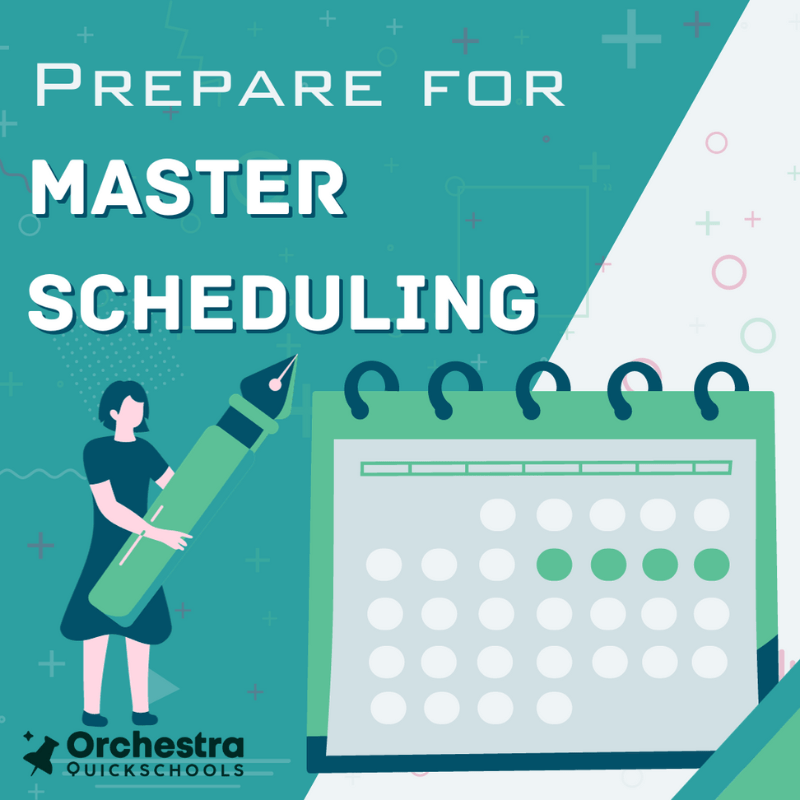Try Orchestra, K12 Scheduler Software!
Master Scheduling for the New Academic Year
The summer break is a well-deserved time for students and educators to relax and recharge. However, as the summer draws to a close, educators and administrators are tasked with a critical responsibility – creating a master schedule for the new academic year. This schedule sets the tone for the entire year, ensuring that students receive the education they need and teachers can effectively plan their lessons. With the help of Orchestra, educators and administrators can easily prepare for master scheduling. It’s always a good idea to be prepared well in advance!
- Try Orchestra, K12 Scheduler Software!
Preparing for Master Scheduling
1. Looking Back at the Previous Year
Before diving into the scheduling process, it’s crucial to gather the necessary data and information. Start by reviewing past data, enrollment numbers, and curriculum requirements. For example,
- Number of students in each grade level
- Number of teachers in each course
- Number of periods in the school day
- Desired start and end times per period
- Course requests from students
- Constraints on the schedule, such as teacher availability, and prerequisites
Looking back at the previous year provides valuable insights for optimizing the upcoming master schedule. By reflecting on our past experiences, we can identify and build upon successful aspects of the schedule. Additionally, collaboration among staff and administrators is essential. Open lines of communication ensure that everyone’s needs and preferences are considered. Fortunately, our online master schedule seamlessly facilitates this as we believe teachers’ input for the Master Schedule process is important.
Here are some key questions to consider:
🗒️ What aspects of last year’s schedule were successful?
🗒️Are there areas where we can grow and improve?
🗒️Did any complications arise from the master schedule?
🗒️Which processes and procedures ran smoothly and which ones need tweaking?
2. Creating a Timeline
Establishing a timeline is vital to ensure that the scheduling process proceeds smoothly. Identify key milestones and deadlines, and communicate them clearly to all stakeholders. While it’s essential to have a plan in place, be prepared for flexibility. Unexpected changes may occur, so having a timeline that can adapt is crucial.
3. Setting Scheduling Goals
Define clear goals for your master schedule. For instance, what does your school aim to achieve? Common objectives include optimizing classroom usage, balancing teacher workloads, and accommodating special programs. If you are aiming to promote equity in teacher workloads, strive for an even distribution, preventing some educators from being overwhelmed with excessive duties while others enjoy lighter schedules. Ultimately, having well-defined goals will guide your decision-making throughout the scheduling process.
4. Setting Constraints
Constraints are the limitations and requirements that must be considered before the scheduling process. These constraints can vary based on school-specific factors and regulations. Some common constraints you can gather include:
Class Size: Different classrooms have varying capacities. It’s essential to ensure that class sizes do not exceed the room’s capacity to provide a safe and comfortable learning environment.
Prerequisites: Certain courses might have prerequisites that students must fulfill before enrolling in them. Scheduling must ensure that students meet these requirements.
Course Offerings: Schools may have a set of core courses that must be offered every term or year. The master schedule must accommodate these mandatory courses.
Fixed Events: Events like assemblies, extracurricular activities, or school meetings can impact the schedule. These fixed events need to be factored in while creating the master schedule.
Allocating Teachers to Courses and Determining Teacher Availability: Assign teachers to the courses they will teach. Each teacher has specific time slots during which they are available to teach. It is crucial to consider these availability constraints when assigning teachers to classes.
Teacher Load: Teachers should have a reasonable workload to maintain teaching effectiveness and avoid burnout. Balancing teacher load across different subjects and grade levels is important.
Special Accommodations: Some students may require special accommodations, such as access to certain facilities or specific time slots for classes.
By considering all the constraints and preferences during the scheduling process, schools can create a master schedule that optimizes resources, maximizes student course availability, and provides a conducive learning environment for all.
Building the Master Schedule
The heart of the scheduling process is, of course, building the master schedule. Here’s a step-by-step breakdown of how to do it with Orchestra:
Step 1: Configure Courses and Teachers
Utilize the data collected earlier during the preparation period, including student and teacher information, available periods, and course requests, as the foundation for creating the schedule.
Users can quickly input all the necessary data, such as course offerings. Orchestra’s intuitive interface allows for easy data entry, ensuring that every piece of essential information is accounted for.
Step 2: Run the Algorithm for Optimal Schedules/Generate your Schedule
Once the data is in place and the draft schedule is ready, users can leverage Orchestra’s powerful algorithm to create an optimized master schedule. All you need to do is click the ‘Run’ button and Orchestra will automatically maximize the efficiency of the schedule.
The algorithm takes into consideration various factors to generate a schedule that is optimized to the highest percentage possible. This ensures that the final schedule meets the school’s unique requirements and minimizes conflicts.
Step 3: Fine-tune with Drag-and-Drop
Orchestra understands that each school’s needs can be unique, which is why the platform provides the flexibility to fine-tune the schedule manually. With the drag-and-drop feature, users can easily make adjustments, move students around, or allocate resources as needed. Use Orchestra’s reporting features to assess teacher workload and room utilization and make necessary adjustments based on the reports.
And you’re done!
Efficiently Orchestrating and Managing Calendar Schedules
Approvals and Finalization
It is important to seek input and feedback from teachers and department heads and obtain final approvals from school administrators or the scheduling committee.
Carefully reviewing and validating the master schedule helps to ensure all constraints are met, stakeholders’ needs are considered, and potential changes are thoroughly assessed before finalizing the schedule.
Monitoring and Adjusting
Continuous monitoring and adjustment are necessary. Be vigilant for scheduling issues that may arise during the year, and address them promptly. Collect feedback from teachers and students, and use this information to refine the schedule.
Communicating the Schedule
Transparent communication with staff, students, and parents is essential. Share the master schedule well in advance, allowing time for adjustments and addressing concerns. Be prepared to handle requests for schedule changes, and communicate any changes clearly.
Distributing the Schedule
Schools can utilize Orchestra’s communication features to distribute the final master schedule to teachers, students, and parents through email notifications and other channels.
Email notifications are an integral part of efficient communication with stakeholders. Through Orchestra’s automated email feature, administrators can promptly inform teachers and students about any schedule changes. The personalized nature of email ensures that recipients receive direct and relevant information, making it an effective way to keep everyone up-to-date.
Additionally, email notifications can be scheduled in advance, streamlining the communication process and allowing administrators to focus on other essential tasks. By leveraging Orchestra’s email notifications, schools can foster clear and consistent communication, leading to better collaboration and a smoother scheduling experience for all parties involved.
Printing the PDF is also an essential method for efficiently communicating the master schedule with stakeholders. Orchestra allows administrators to generate the master schedule as a PDF document, which can then be easily printed and distributed to teachers, students, and parents. This physical copy serves as a tangible reference, especially for those who prefer traditional documentation. It can be posted on school bulletin boards, shared during parent-teacher conferences, and kept as a handy backup for quick access.
Seamless Harmony: Orchestra’s Integration with Your SIS
Another plus point of using Orchestra is that our online master scheduler software integrates seamlessly with your current SIS. Our skilled team can effectively import all the necessary data from your existing SIS, allowing Orchestra to effortlessly create your personalized master schedule. School administrators can take advantage of Orchestra’s features no matter which SIS they currently utilize, further simplifying your master scheduling process.
Creating a master schedule for the new academic year after summer break is a complex task. It’s a dynamic document that requires careful planning, collaboration, and flexibility. But, it can be rewarding with the help of a dynamic K12 scheduler software. Administrators and educators can ensure that the new school year starts with a well-structured and effective master schedule that benefits everyone involved. Remember, a well-crafted schedule sets the stage for a successful academic year ahead.







2 thoughts on “Need to Prepare for Master Scheduling?”